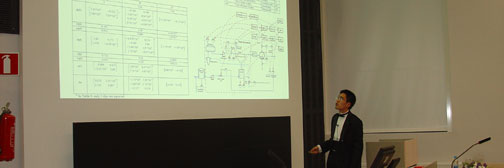| | Year 2005
Tommi LiimatainenGloss model for an on-line multinip calender
On-line multinip calenders integrated as part of paper machines have proliferated rapidly amid efforts to reduce investment costs and streamline the paper making process. The surface quality of calendered paper and runnability of the calender are dependent on the production phases leading to the on-line calender. Despite cross- and machine-directional faults in the paper web, the calender should produce paper without interruptions, production should be cost-efficient, and the paper should be acceptable to the customer. With paper machine speeds constantly increasing, this has posed new challenges for the on-line calender’s control systems. As a result, there is a call for process equations that can characterize the quality of SC paper. Equations are needed for developing a new gloss control system for an on-line multinip calender. The new gloss control system should be able to respond to the profile changes appearing in uncalendered paper, accurately and effectively.
The target of the study was to develop equations and procedures for modeling gloss for calendered paper based on the modeling methods introduced in the literature part of the thesis.
The first goal was to review modeling methods for the calendering process found in literature. The literature part of the study examines SC paper as a product, the basics of on-line multinip calendering and the control strategies of the modern calender. The fundamentals of model predictive control are also presented. The most common calendering models and equations are introduced as a basis for the modeling work presented in the experimental study. The modeling tools utilized here are factor analysis, regression analysis and neural networks.
In the experimental section of this thesis, the regression models for top and bottom side paper gloss were developed based on pilot data and mill data. Neural network models from the pilot and mill data for the top and bottom gloss of paper were also generated.
The experimental part of this thesis presents the analysis and statistics of the pilot and mill data, the conclusions of the modeling work and the finished regression and neural network models for the top and bottom gloss of paper. The modeling methods used in the experimental part of the study are introduced in the literature part of the thesis.
The most useful regression method found in the experimental part of the thesis was polynomial regression. Factorial regression was also reliable in predicting paper gloss, but the factorial regression models became very complicated, which made them impracticable. Polynomial regression models were more efficient than multiple regression models and were found to be advantageous in further R&D work and controller design. The results from the neural networks were promising and could be considered reliable based on the experiment results.
Deprecated: strlen(): Passing null to parameter #1 ($string) of type string is deprecated in C:\WWWroot\Root\incs\5_theses\theses_new2010.php on line 248
This info last modified 27 Apr 2024 by Jerri Kämpe-Hellenius
|

